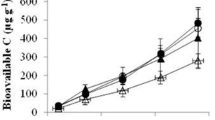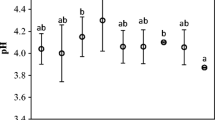Abstract
Acacia melanoxylon, a N2-fixing timber tree occurring naturally in eastern Australia, is now promoted as a component of silvopastoral systems; but the interaction of the tree with pasture and soils has not been adequately studied. This study investigated the effects of Acacia melanoxylon on soil nitrogen (N) levels, N availability, soil pH, bulk density, organic carbon, C:N ratios and soil moisture in three separate silvopastoral sites with contrasting soil types in the North Island of New Zealand. At each site four tree stocking rates were studied (0, 500, 800, and 1700 stems ha−1). The trees were nine years old at the time of the study. Soil samples from each study site were taken once at three depths (0 to 75 mm, 75 to 150 mm, and 150 to 300 mm), with three replicates per tree stocking rate. Soil analyses showed that although there were differences between soil types, few statistically significant differences occurred due to tree stocking rate. A greenhouse pot trial growing ryegrass (Lolium multiflorum L. cv. ‘Concord’) in soil from the ‘A’ horizon of each soil type from under the trees and the open pasture found that ryegrass yield, N uptake and N supply increased with increasing tree stocking rate. Increased N supply under the trees, coupled with greater soil moisture compared to the open pasture may have accounted for the higher pasture yield under Acacia melanoxylon compared to non dinitrogen fixing tree species. This study suggested that Acacia melanoxylon in a silvopastoral system had the potential to increase soil N availability.
Similar content being viewed by others
References
Blakemore L.C., Searle P.L. and Daly B.K. 1987. Methods for chemical analysis of soils. New Zealand Soil Bureau Scientific Report No. 80., 130 pp.
Broadbent F.E. 1953. The soil organic fraction. Advances in Agronomy 5: 145–183.
Bremner J.M. 1996. Nitrogen total. In: Sparks D.L. (ed.), Methods of Soil Analysis. Part 3: Chemical Methods. Soil Science Society of America Inc, Madison, Wisconsin, USA, pp. 1085–1122, Book series No. 5.
Côté B. and Camiré C. 1987. Tree growth and nutrient cycling in dense plantings of hybrid poplar and black alder. Canadian Journal of Forest Research 17(6): 516–523.
Eastham J. and Rose C.W. 1988. Pasture evaporation under varying tree planting density in an agroforestry experiment. Agriculture Water Management 15(1): 87–105.
Frederick D.J., Madgwick H.A.I., Jurgensen M.F. and Oliver G.R. 1985. Dry matter, energy, and nutrient contents of 8-year-old stands of Eucalyptus regnans, Acacia dealbata, and Pinus radiata in New Zealand. New Zealand Journal of Forestry Science 15(2): 142–157.
Genstat 5 Committee 1993. Genstat 5, Release 3. Reference Manual. Clarendon Press, Oxford, 796 pp.
Giddens K.M., Parfitt R.L. and Percival H.J. 1997. Comparison of some soil properties under Pinus radiata and improved pasture. New Zealand Journal of Agricultural Research 40: 409–416.
Hawke M.F. and O'Connor M.B. 1995. Soil pH and nutrient levels at Tikitere agroforestry research area. New Zealand Journal of Forestry Science 23(1): 40–48.
Luken J.O. and Fonda R.W. 1983. Nitrogen accumulation in a chronosequence of red alder communities along the Hoh river, Olympic National Park, Washington. Canadian Journal of Forest Research 13(6): 1228–1237.
New Zealand Meteorological Service 1983. Summaries of Climatological Observations to 1980. New Zealand Meteorological Service miscellaneous publication 177., 172 pp.
Hewitt A.E. 1993. New Zealand Soil Classification. Landcare Research Science Series No. 1. Manaaki Whenua - Landcare Research New Zealand Ltd., Dunedin, 133 pp.
Power I.L., Dodd M.B. and Thorrold B.S. 1999. A comparison of pasture and soil moisture under Acacia melanoxylon and Eucalyptus nitens. Proceedings of the New Zealand Grassland Association 61: 203–207.
Scanlan J.C. and McKeon G.M. 1993. Competitive effects of trees on pasture are a function of rainfall distribution and soil depth. Proceedings of the XVII International Grasslands Congress III: 2231–2232.
Smith G.S., Johnson C.M. and Cornforth I.S. 1983. Comparison of nutrient solutions for growth of plants in sand culture. New Phytologist 94(4): 537–548.
Smith G.S., Cornforth I.S. and Henderson H.V. 1985. Critical leaf concentrations for deficiencies of nitrogen, potassium, phosphorus, sulphur, and magnesium in perennial ryegrass. New Phytologist 101(3): 393–409.
Soil Survey Staff 1992. Keys to Soil Taxonomy. The Soil Management Support Services technical monograph No. 19. 5th edn. Pocahontas Press, Inc, Blacksburg, Virginia, 556 pp.
Steele K.W. and Percival N.S. 1984. Nitrogen fertiliser application to pastures under Pinus radiata. New Zealand Journal of Agricultural Research 27(1): 49–55.
Thorrold B.S., Knowles R.L., Nicholas I.D., Power I.L. and Carter J.L. 1997. Evaluation of agroforestry options for three tree species. Proceedings of the New Zealand Grassland Association 59: 187–190.
Wall A.J., Mackay A.D., Kemp P.D., Gillingham A.G. and Edwards W.R.N. 1997. The impact of widely spaced soil conservation trees on hill pastoral systems. Proceedings of the New Zealand Grassland Association 59: 171–177.
Wang X.J., Smethurst P.J. and Herbert A.M. 1996. Relationships between three measures of organic matter or carbon in soils of eucalypt plantations in Tasmania. Australian Journal of Soil Research 34(4): 545–553.
Wedderburn M.E. and Carter J.L. 1999. Litter decomposition by four functional tree types for use in silvopastoral systems. Soil Biology and Biochemistry 31: 455–461.
Young A. 1989. Agroforestry for Soil Conversation. CAB International, Wallingford, United Kingdom, 276 pp.
Author information
Authors and Affiliations
Corresponding author
Rights and permissions
About this article
Cite this article
Power, I., Thorrold, B. & Balks, M. Soil properties and nitrogen availability in silvopastoral plantings of Acacia melanoxylon in North Island, New Zealand. Agroforestry Systems 57, 225–237 (2003). https://doi.org/10.1023/A:1024838311287
Issue Date:
DOI: https://doi.org/10.1023/A:1024838311287




